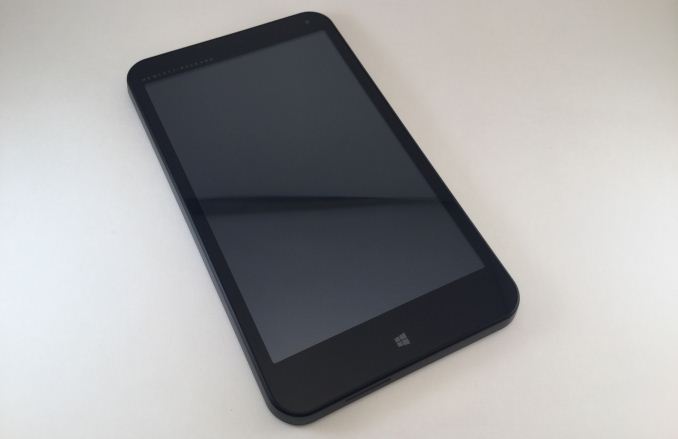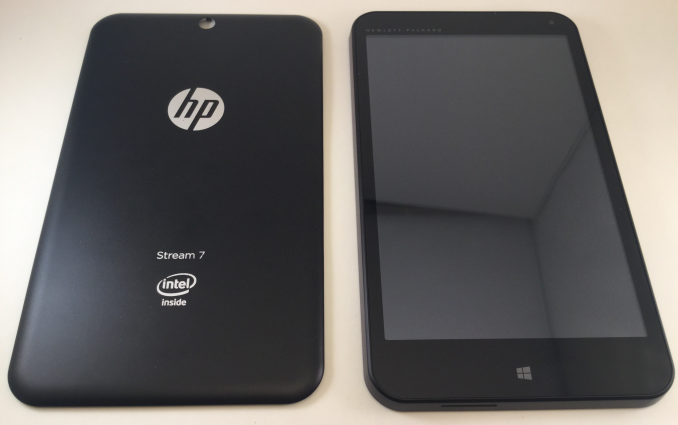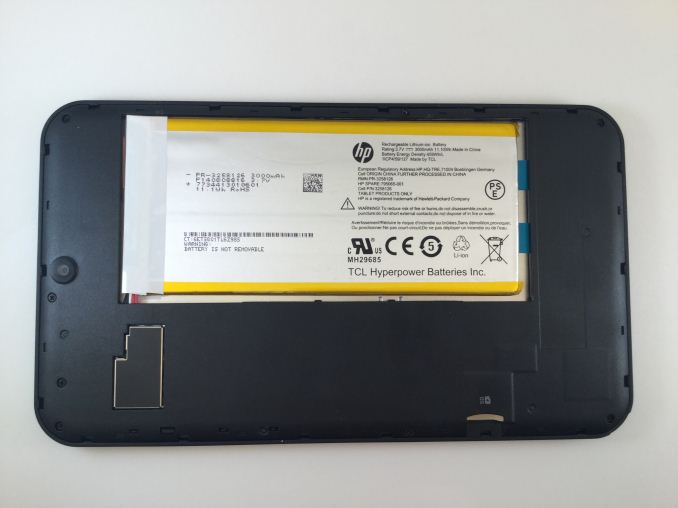HP Stream 7 Review: A $119 Windows Tablet
by Brandon Chester on December 19, 2014 8:00 AM EST
Late last month, we published our annual holiday guide for people interested in buying tablets. We took a look at what we considered to be the best tablets running iOS, Android, and Windows as these have become the three dominant operating systems among tablets. That being said, users are likely more familiar with iOS and Android tablets than they are with ones that run Windows, myself included.
There's significantly less coverage of Windows devices, and they generally don't attract the same sort of attention as high profile launches like Apple's iPad and Google's Nexus tablets. This makes it somewhat challenging to determine what Windows tablets are good recommendations, and I had to take a look at what owners of Windows tablets were saying about their experiences. During my search, I came across a tablet that was genuinely interesting. I had seen it previously in posts about Black Friday and Cyber Monday deals, and the reason I found it to be so interesting was because of its low price. The tablet that I speak of is the HP Stream 7.
The Stream 7 is priced at $119, which makes it an extremely inexpensive tablet that sits alongside cheap tablets that have traditionally run Android. Around the Black Friday shopping period, it was at an even lower price of $99. In fact, even today you can still find the Stream 7 on Amazon for $99. When I first saw it, I assumed there had to be a catch. I thought it might be running Microsoft's failed Windows RT platform, but in fact it runs a complete copy of Windows 8.1 and is compatible with all the legacy applications you're familiar with on your laptop and desktop computers.
This is the result of Microsoft's Windows 8.1 with Bing initiative, which allows manufacturers to ship low-cost Windows devices without having to pay Microsoft a licencing fee for including Windows. I find this remarkable, as a separate copy of Windows 8 can cost as much as the Stream 7 that includes it as part of the package. It turns out that there isn't really a catch; there are simply hardware compromises that need to be made to achieve such a low price point. I've put the specifications of the Stream 7 in a chart below so you can get an idea of exactly what $119 gets you.
| HP Stream 7 | |
| SoC | Intel Atom Z3735G 1.33GHz quad core Bay Trail with 1.83GHz burst speed |
| RAM/NAND | 1GB DDR3L-RS-1333, 32GB NAND + microSDHC |
| Display | 7" 1280x800 eIPS LCD |
| Dimensions | 192.78 x 110.74 x 9.90 mm, 353.8g |
| Camera | 2MP Rear Facing , 0.3MP Front Facing |
| Battery | 3000mAh, 3.7V (11.1Wh) |
| OS | Windows 8.1 with Bing |
| Connectivity | 802.11b/g/n + BT 4.0 , USB2.0, Miracast |
As you can see, it's actually a bit better than you might expect from a $119 device. Many Android tablets at this price point either use TN displays, or sport resolutions of 1024x600 or even 800x480. The quad core Atom CPU should also be capable of running Windows smoothly given the tasks that users will typically perform on a tablet. The points of concern are the battery capacity, which is quite low for a 7" tablet, and the inclusion of only 1GB of memory; that's definitely pushing the limits of what Windows can run on.
The design and build quality of the Stream 7 is what you'd expect from a $119 tablet. It's somewhat heavy, and it definitely won't be winning any awards for thinness. The construction is entirely plastic, aside from the glass on the front that appears to be more reflective than any other device I own. Viewing the device in portrait orientation, the left and right sides of the display have identical thin bezels, while the top and bottom have thicker asymmetric bezels with the bottom one being larger. The top bezel is home to a 0.3MP front-facing camera on the right, and the name HEWLETT-PACKARD on the left just in case you forget which company made your tablet. The bottom bezel has a single capacitive button with the Windows logo, which acts as the start menu key.
The right side houses the volume rocker and power button, the top has the 3.5mm combo jack and the microUSB port, and the bottom has a small slit for the mono speaker. Something that is interesting to note is that the sides of the tablet are slanted, so the width is greater near the back cover than near the display. It's an interesting design choice that makes it stand out from other tablets. It doesn't seem to make it feel any easier or harder to hold; it just feels different.
The back cover of the Stream 7 is adorned with logos. From bottom to top we have the Intel logo, the name of the tablet, and a very large HP logo. Above the HP logo is a center-aligned 2.0MP camera. Beneath all the logos is a sticker with regulatory info that thankfully comes off quite easily. Something that doesn't show up in marketing images of the Stream 7 is the sparkly pattern on the back cover. It's not a completely black back cover, as it has speckles that show up when you shine light on it.
The back of the device is unfortunately also where the issues of build quality begin to crop up. The Stream 7 has a removable back cover, but it only serves the purpose of accessing the MicroSD slot in the back of the device as well as the officially non-removable battery. The problem is that there's a large gap between the back cover and the back of the tablet body, which means that there's significant flex to the back of the tablet. HP could have made their device thinner and more rigid by having a non-removable back without the gap between it and the components beneath it. The MicroSD could have been made accessible through some slot on the side. That being said, at a price point of $119 or less this is honestly excusable; you get what you pay for with regards to build quality.












157 Comments
View All Comments
rootheday3 - Saturday, December 20, 2014 - link
Brandon-You say on the Display page of the review:
"It should be noted that these measurements were achieved by disabling Intel's Display Power Saving Technology (DPST) feature, which causes dynamic brightness and contrast depending on the image displayed on the screen. While some other devices do this to some degree, DPST ended up reducing max brightness measurements by nearly 100nits, and the constantly changing brightness played havoc with measurements during analysis and calibration."
and also on the battery life page:
"It's likely that enabling Intel's DPST will improve these results, but all that really means is that dimming the display below our 200nits standard will improve battery life."
DPST shouldn't reduce overall brightness - the algorithm it uses is designed to detect dark scenes and change the panel gamma curve to let more light through while reducing the backlight intensity to match. If working properly this can save a lot of backlight power on scenes that have low luminance values and moderate contrast to start with (e.g. movie watching). Normally there should be no noticeable difference in overall brightness of the image (though there may be a second or two of visible modulation if the image suddenly changes from bright to dark or vice versa). If you are seeing drops of 100 or 200 nits brightness when DPST is active, something isn't right.
For what its worth, other devices use techniques (called CABC - content adaptive backlight control) that do the same things as DPST - they generally just don't give you control over it the way that Intel's control panel does.
Are you 100% confident that the visual issues and brightness issues you are describing are isolated to this device or to Intel DPST in general and that other mobile devices don't have similar dimming going on?
Any possibility thaty you are conflating DPST vs Automatic Display Brightness (ADB) based on ambient light sensor detected brightness variations in the room?
Backlight is a huge contributor to platform power in tablets and other very low power mobile devices -If you only disable DPST on Intel platforms but don't disable CABC on other platforms, your low battery life results are perhaps not fair...
Note also that the Intel control panel offers an aggressiveness slider for DPST - can you reduce the aggressiveness value and see if that makes it better visually?
Brandon Chester - Saturday, December 20, 2014 - link
Some other devices do it in the video test, but not in the web browsing test. You can see the brightness of the Stream 7 decrease when you load a very white web page, and it goes back up when you return to somewhere like the Start Screen. This doesn't happen on an iPad. You can see in our Asus UX21 review that DPST does reduce the brightness when showing an all white screen, so I don't think there's anything wrong with my statement that DPST was reducing max brightness in our test.Oh and no, it wasn't ADB, I disabled that right when I set up the tablet.
Laststop311 - Saturday, December 20, 2014 - link
Smaller battery than note 4 phone thats only 5.7" is worriesome. This tablet could of been really good if they just upped the ram to 3GB and upped the battery to 4000+mah. I think it would of sold more if they raised the price an extr 25 for the extra 2GB of ram and an extra 15 for the extra 1000mah of battery. Doesn;t a tablet like that for 159 sound a lot better than the current one for 119Laststop311 - Saturday, December 20, 2014 - link
Wouldn't mind seeing a 64GB option for 30-50 more as wellados_cz - Sunday, December 21, 2014 - link
They can't up the ram without changing the CPU which in turn would increase the price further more, the atom Z3735G is limited to maximum of 1GB of ram. But the ram is not problem on this device, I hard-set swap file to 2GB on my Linx 7 (same atom) and it runs just great.Roy2001 - Saturday, December 20, 2014 - link
I have stream 8, Intel Soc performs very well, but OS is not so good.andrewaggb - Sunday, December 21, 2014 - link
I have a 64gb miix 2 8" windows tablet. Picked it up used/cheap. It's pretty decent, but the quantity of windows updates are a bit ridiculous. The app selection is much different, but there's plenty of games and apps my kids like on it. My daughter probably prefers it to the ipad, my son definitely prefers the ipad.Desktop apps suck on it, they run fine, but the screen is too small in my opinion.
Performance wise I think it runs fine.
Battery life is ok, but not as good as an ipad.
I imagine the stream 7 is very similar. For $100 it's probably a great deal. You also get full flash support, which I use for some streaming applications.
spdfreak - Sunday, December 21, 2014 - link
I wonder if these are basically the same as the Winbook Tablets that MicroCenter sells. The MC 7in tablet is 60.00 in today's ad. The 8in with 2GB Ram is 140.00.HD IPS LCD 7" 1280x800 Display
Intel BayTrail-T Z3735G 1.33GHz Quad-Core CPU
1GB RAM & 16 Flash Storage
Windows 8.1 OS
Expandable up to 64GB via microSD Card
The WinBook 7" TW700 Tablet has 16GB of integrated storage, which can be expanded via microSD Card. Includes 1 year subscription for Office 365 Personal.
darkich - Sunday, December 21, 2014 - link
Good review, and I agree that spec wise this is probably the best tablet for the price.But I would rather recommend buying an used Android tablet for this price.
For 110$ I got an aluminum 8“ IPS (excellent Samsung panel) 800p quad core 3G tablet with 2+5Mpix cameras, even radio, GSM and GPS. Slim, stylish and just 340g of weight. Still 20 months of warranty and in pristine condition.
Finally, for a tablet use case Android is definitely a much better choice than Windows.
jkauff - Sunday, December 21, 2014 - link
For less than a hundred bucks I can play movies on a handheld device using MPC-HC and madVR on default settings. Pretty cool. BTW, I fixed my headphone jack with a shot of compressed air and a bit of contact cleaner. It wasn't defective, just dirty.